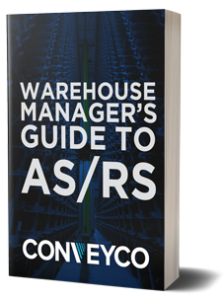
Automated Storage & Retrieval Systems (AS/RS)
Automated Storage and Retrieval Systems—often referred to as AS/RS (sometimes seen as AS-RS or ASRS)—are a type of warehouse technology wherein goods are automatically placed into, and brought back out of, storage as needed. This is typically achieved by pairing the technology with warehouse execution software (WES) that manages the process and helps warehouse personnel process orders.
Need an Expert Opinion?

Pallet Shuttle Systems for Cold Storage Warehouses
Pallet Shuttle AS/RS Systems

Mid-Load AS/RS

Horizontal Carousel
Though Automated Storage and Retrieval Systems were originally designed to provide long-term storage for product in a way that makes the best use of a facility’s space, modern AS/RS technology has many applications, the most important of which include:
- Order Selection and Staging
- Sequence Buffering
- Work in Progress Buffering (WIP)
- Dynamic Replenishment
- Goods-to-Person Picking
By aiding an operation in these processes, AS/RS brings with it a slew of benefits that contribute to a healthy bottom line:
- Reduced labor costs and fewer labor constraints in locations with tight labor markets
- Increased workplace safety and fewer accidents
- Improved accuracy, productivity, and efficiency all along the supply chain
- More efficient use of space, especially important for operations constrained by small footprints which might otherwise necessitate an expensive expansion or relocation
Fortunately, these benefits are not limited to any particular industry. Brick & mortar, eCommerce, and Omni-channel operations across all sectors—manufacturing, food & beverage, medical & pharmaceuticals, apparel, tech, etc.—can all implement AS/RS technologies in their facilities to boost efficiency and productivity while lowering labor and other costs.
Types of Automated Storage and Retrieval Systems (AS/RS)
Automated storage and retrieval systems come in two main flavors: Unit-Load AS/RS and Mini-Load AS/RS. Within Mini-Load is a third subtype known as Goods-to-Person (G2P).
Unit-Load automated storage and retrieval systems typically handle larger loads of goods and material (including weights measuring in thousands of pounds). Often, this means that the AS/RS tech is handling and moving full or partial pallets or cases. Unit-Load AS/RS is a great option when pallet-level storage is limited and quick retrieval is critical.
Common types of unit-load AS/RS include fixed-aisle and movable-aisle unit-load cranes.
Compared to Unit-Load AS/RS, Mini-Load AS/RS typically handles smaller loads of product. Instead of full pallets, this often translates into a Mini-Load AS/RS handling totes, trays, or cartons. These systems are sometimes also called “case-handling” or “tote-stacking” systems. Mini-Load AS/RS is especially well suited for operations that require storage locations for a large amount of SKUs but which lack the floor space required for traditional carton-flow shelving to provide a pick face for each SKU. Mini-Load AS/RS systems can also be used to buffer and efficiently release/sequence product to picking or palletizing stations, and can be used to automatically replenish pick locations like carton-flow.
Common types of Mini-Load AS/RS include Mini-Load AS/RS cranes and shuttles, carousel-based AS/RS, and Vertical Lift Modules.
Goods-to-Person (G2P) falls within Mini-Load AS/RS as a subtype best suited for split case order fulfillment. Though there are different types of G2P technology, the general principle remains the same: An Automated Storage System delivers SKUs to a stationary pick station, where the operator fills discrete orders.
Factors to Consider Before Selecting an AS/RS Solution
If you are considering implementing an Automated Storage and Retrieval Solution in your operation, it is worthwhile putting some thought to the considerations below, as these data points will prove pivotal in your discussions with a systems integrator or warehouse design consultant:
- Throughput: How many hourly transaction/number of cycles are required by aisle?
- Storage locations: What is the required capacity of the system? Is it single or double deep?
- Product Specifications: What will be handled?
- SKU Data: How much of each SKU will be stored? Based on its movement, should it be spread across multiple aisles of consolidated?
- Order Profile: What is the order profile of the outbound work? Should SKU affinity be a consideration?
- Weight: Some machines have a per tote capacity which is better suited to different product types.
- Speed: Different machines have different down aisle speeds based upon the type of mast or shuttle, its mass, and maximum velocity.
- Aisle length: Different machines will have a length of the aisle which is optimum for acceleration and deceleration and will provide the maximum dual cycle throughput in an hour.
AS/RS Resources
If you’d like to learn more about the topic of Automated Storage and Retrieval Systems (AS/RS), we encourage you to read some of the resources that we’ve written on the subject:
Pallet Shuttle Systems: What They Are and What They Do

Lane Automotive Revs Up Order Fulfillment with High Performance Exotec Skypod
Automating with the “RightFIT” Solution in Mind
Our AS/RS capabilities are among the most advanced in the industry. We have successfully designed and installed some of the highest-rate systems in all of North America, for operations in a wide range of industries and specialties.
Conveyco has designed and implemented custom solutions for clients for over three decades. Learn more about our design build process, or request a complimentary consultation with one of our expert systems integrators today.



